14 Cactus Garden Ideas for Stylish and Low-Maintenance Outdoor Spaces
Cactus gardens offer a unique way to bring beauty and low-maintenance greenery into outdoor spaces. They are well-suited for various climates because they require little water and care while adding interesting textures and shapes.
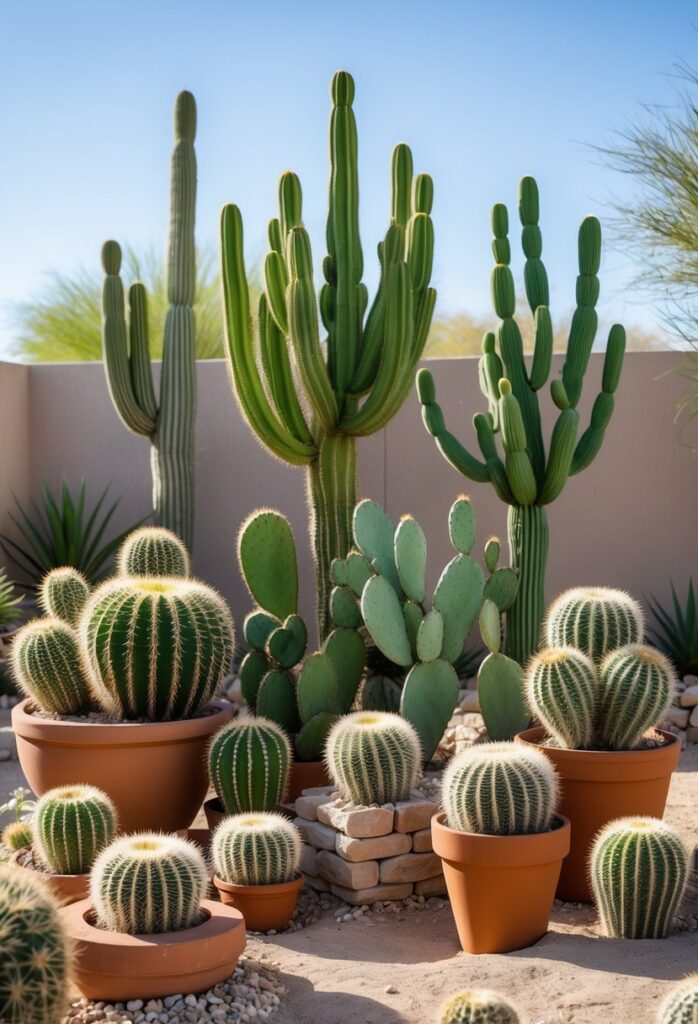
These 14 cactus garden ideas provide practical and attractive ways to design a garden that stands out without demanding much upkeep. Whether for a backyard or a small container garden, these ideas help to create a stylish and drought-resistant outdoor area.
1) Group small cacti of varying textures and colors for visual contrast
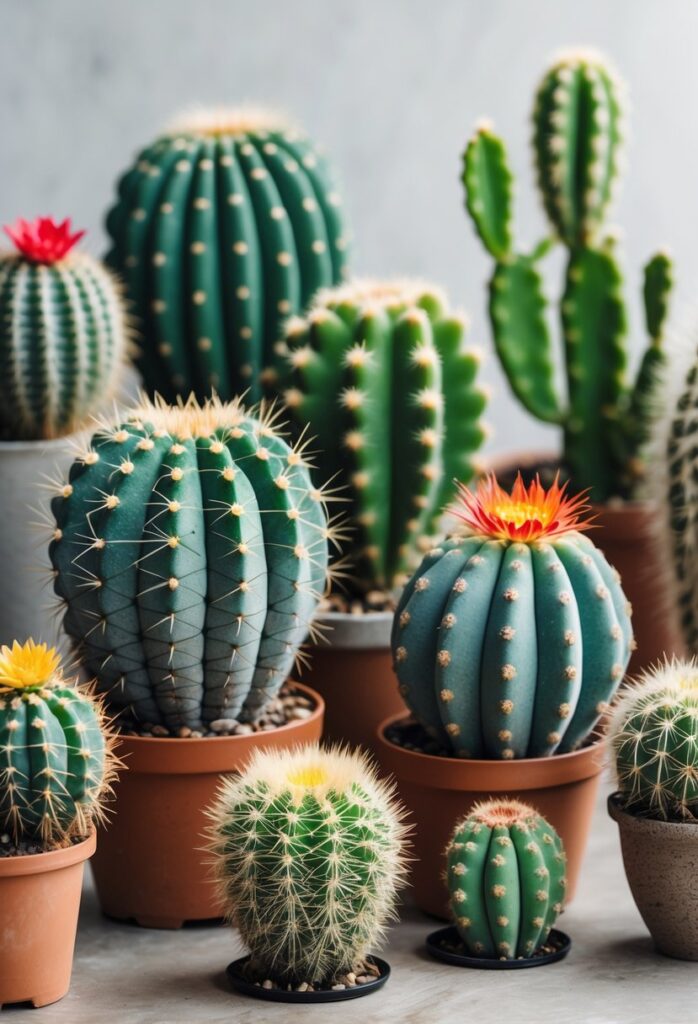
Grouping small cacti with different textures creates interest in a garden. Plants with smooth, spiky, or fuzzy surfaces next to each other catch the eye. This variety helps keep the space from looking flat or dull.
Adding different colors, like green, red, or purple, enhances the contrast. Mixing shapes also adds to the effect. Round, tall, or clustered cacti placed together form a pleasing and balanced arrangement.
Small cacti grouped tightly work well in limited spaces. This method gives a neat and tidy look while showing the unique features of each plant. They can be placed in containers or garden beds for a striking display.
Using small cacti with diverse textures and colors is an easy way to make a cactus garden appealing. It requires little maintenance but offers a lot of visual interest. This strategy suits both beginners and experienced gardeners.
2) Create gravel beds with white, black, or red stones for a minimalist backdrop
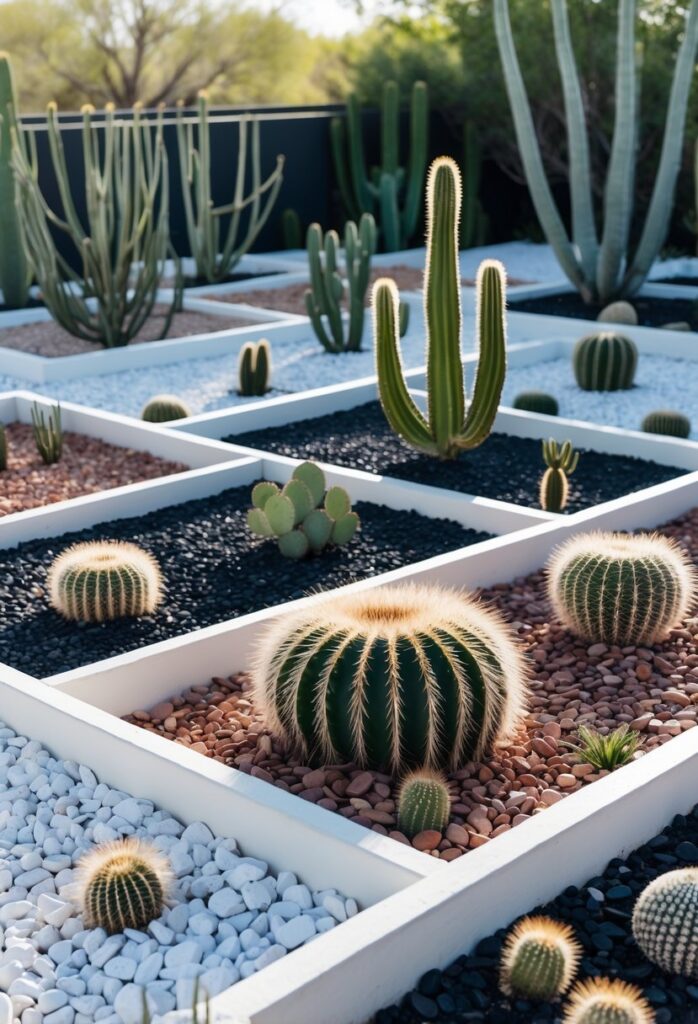
Using gravel beds with white, black, or red stones can give a cactus garden a clean and simple look. These colors help the green shapes of the cacti stand out without distraction.
White stones reflect light and create a bright, fresh feeling. Black stones add contrast and make the garden feel more modern. Red stones bring warmth and a natural touch, often matching desert themes well.
Gravel also helps with drainage, which cacti need to stay healthy. It stops water from pooling at the roots and keeps weeds down.
A gravel bed is easy to install by preparing the soil, laying landscaping fabric, then spreading gravel evenly. This creates a neat base that lasts a long time with little care.
Choosing the right stone size can change the texture. Smaller gravel looks smooth and even, while larger stones add roughness and detail.
Overall, gravel beds with these stone colors support the minimalist style and add a practical feature to cactus gardens.
3) Incorporate succulents with vibrant orange, purple, and green hues

Adding succulents with bright orange, purple, and green colors can bring life to a cactus garden. These colors contrast well with the neutral tones of many cacti, making the garden more visually interesting.
Orange succulents like certain types of sedum or echeveria add warmth and energy. Purple varieties offer depth and richness. Green succulents create balance and help tie the colors together.
Grouping these succulents in small clusters enhances their impact. Planting taller ones at the back and smaller ones in front also adds dimension. Combining colors carefully ensures that no single hue overwhelms the space.
Succulents prefer good drainage and full sun, just like cacti. Using rocks around the plants adds texture and helps with water flow. This mix of colors, shapes, and textures creates a dynamic environment that remains easy to care for.
4) Use rocks of different sizes to add natural structure to the garden

Using rocks of various sizes helps create a natural look in a cactus garden. Large boulders can serve as focal points and offer strong visual interest. Smaller stones and gravel fill gaps and make the space feel full without overcrowding.
Different rock sizes give the garden depth and texture. This variety can also highlight the shapes of the cacti. Placing bigger rocks around smaller plants makes the plants stand out more.
Rocks can act as natural borders too. They help define areas in the garden, like paths or planting beds. This keeps the garden organized while still feeling organic.
Mixing sizes also helps with drainage. Gaps between rocks allow water to flow freely, which suits cactus roots that need well-drained soil. This simple structure supports healthy plant growth.
5) Choose round or oval-shaped cacti covered in white spikes for fluff-like texture

Round or oval-shaped cacti with white spikes can add a soft, fluffy look to a cactus garden. The white spines often create a dusted or fuzzy appearance that contrasts well with other plants. This texture helps break up the harder, spikier shapes in the garden.
These cacti often have compact shapes that work well in small or grouped arrangements. Placing several of them together can create a visually interesting patch with varied shades of green and white.
The white spikes also reflect light differently, making the cacti stand out in bright sun. They give the garden a cooler, more delicate feel despite being desert plants.
Using these types of cacti adds both texture and depth without needing many different species. They fit well in rock gardens or combined with succulents for a mixed but harmonious look.
6) Design a desert-inspired layout blending tall and short cacti
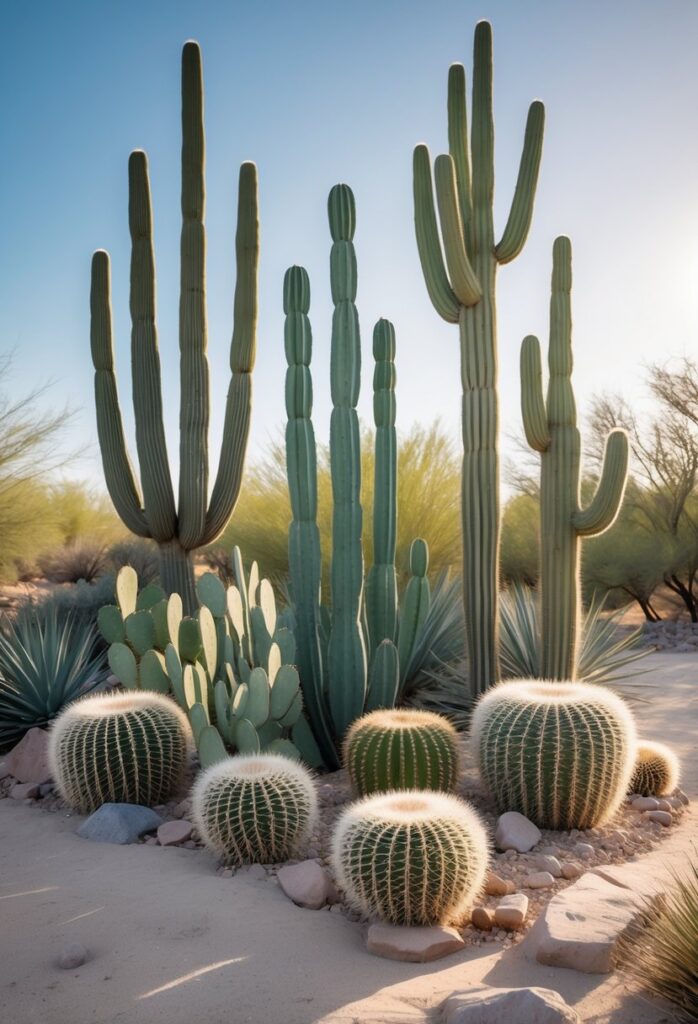
A good cactus garden uses different heights to create balance and interest. Tall cacti, like saguaros or organ pipe varieties, serve as strong focal points. They can be placed in the back or center of the garden to draw the eye.
Medium-sized cacti, such as barrel cacti, work well around the taller plants. They add contrast and help transition from tall to low growth. Small cacti and succulents can fill spaces near the front or edges.
Mixing shapes and textures is important. Combining columnar, round, and spiky cacti brings variety without crowding. This layered approach gives the garden depth and makes it look natural.
Adding rocks or gravel can enhance the desert feel. It also helps with drainage, which cacti need. Designing the garden with this mix of height, texture, and materials creates a clear, desert-inspired look that is visually appealing and easy to maintain.
7) Plant cacti in raised beds or containers for better drainage
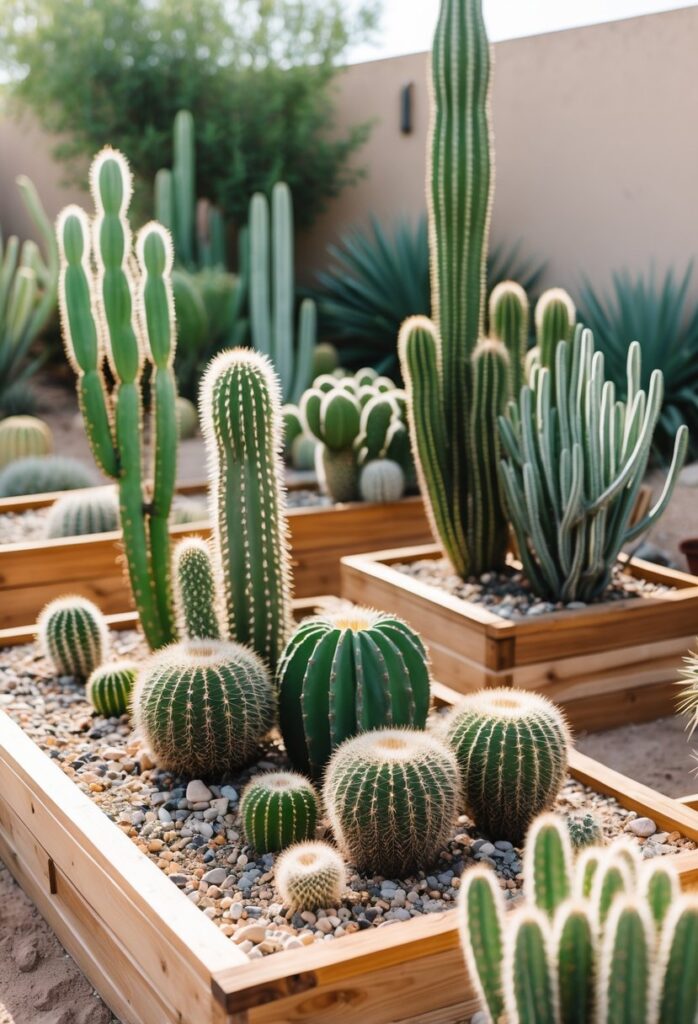
Raised beds help keep the soil warm and improve drainage. This is important because cacti do not like to sit in wet soil, which can cause root rot. By planting cacti in raised beds, excess water drains away more easily.
Containers also provide good drainage if they have holes at the bottom. Most cacti have shallow roots, so wide but shallow pots work well. Containers allow better control over soil type and watering.
Using raised beds or containers makes it easier to group different types of cacti. This helps with watering routines and soil care. It also protects the plants from foot traffic and pets.
Good drainage is key to cactus health. Raised beds and containers create an environment that suits cacti’s needs better than flat garden soil. This simple step can lead to stronger, healthier plants.
8) Mix bright green and dark red cacti for bold color combinations
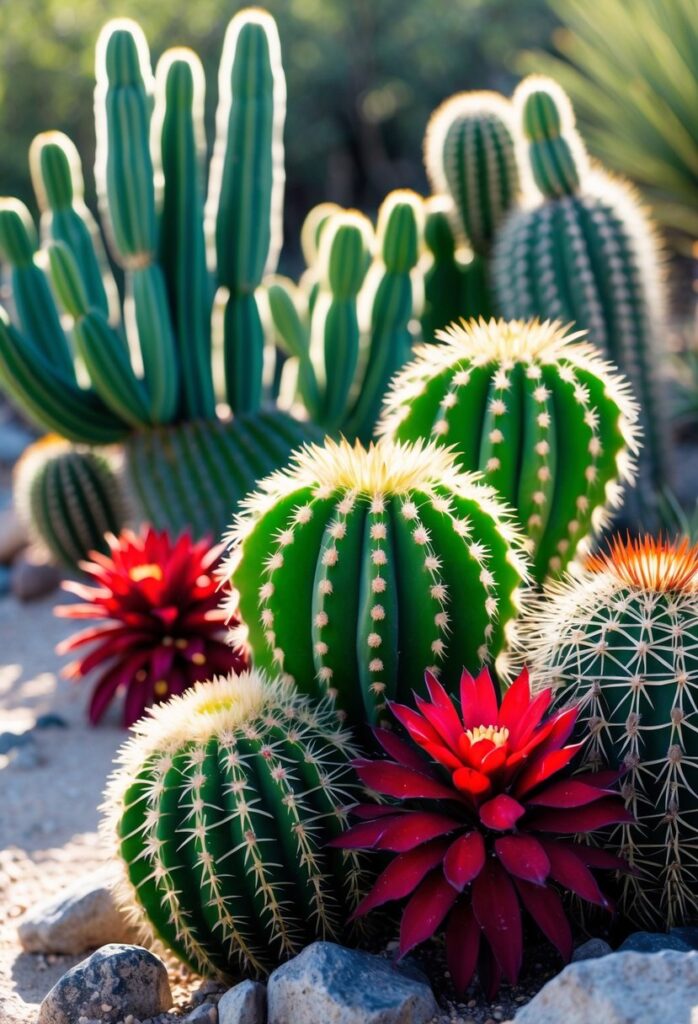
Using bright green and dark red cacti creates a striking contrast. This combination adds visual interest without overwhelming the garden. The colors naturally complement each other and help define space.
These colors work well in small clusters. Placing dark red cacti next to bright green ones draws the eye. It breaks up monotony and adds variety.
The color mix is especially good for gardens with simple designs. It gives a pop of color without extra decorations. These bold colors can make an ordinary garden look more dynamic.
Combining different shapes with these colors enhances texture. Round or oval green cacti paired with dark red spiky ones create balance. This adds depth to the arrangement.
This approach suits both indoor and outdoor gardens. With minimal care, the color contrast makes the cactus garden feel lively. It is an easy way to improve garden aesthetics.
9) Include flowering cacti varieties to add seasonal interest

Flowering cacti bring color and life to a garden, especially during their bloom season. Their flowers can range from bright pinks to soft whites and add a fresh look to a space that otherwise focuses on green and spiky textures.
These cacti are generally low-maintenance, making them suitable for both beginners and experienced gardeners. They thrive in well-draining soil with minimal water and plenty of sunlight.
Adding flowering varieties like the Christmas Cactus or Easter Cactus offers color during specific times of the year. These plants perform well indoors and outdoors, making them a flexible option for many garden designs.
Choosing compact species with vibrant flowers helps fill smaller spaces or containers. This makes it easier to bring seasonal beauty into patios, window sills, or garden corners.
Proper care, including the right soil, light, and watering schedule, encourages healthy blooms. Gardeners should avoid overwatering and provide enough light to see the flowers fully develop.
10) Create a mini indoor cactus garden with low-maintenance species
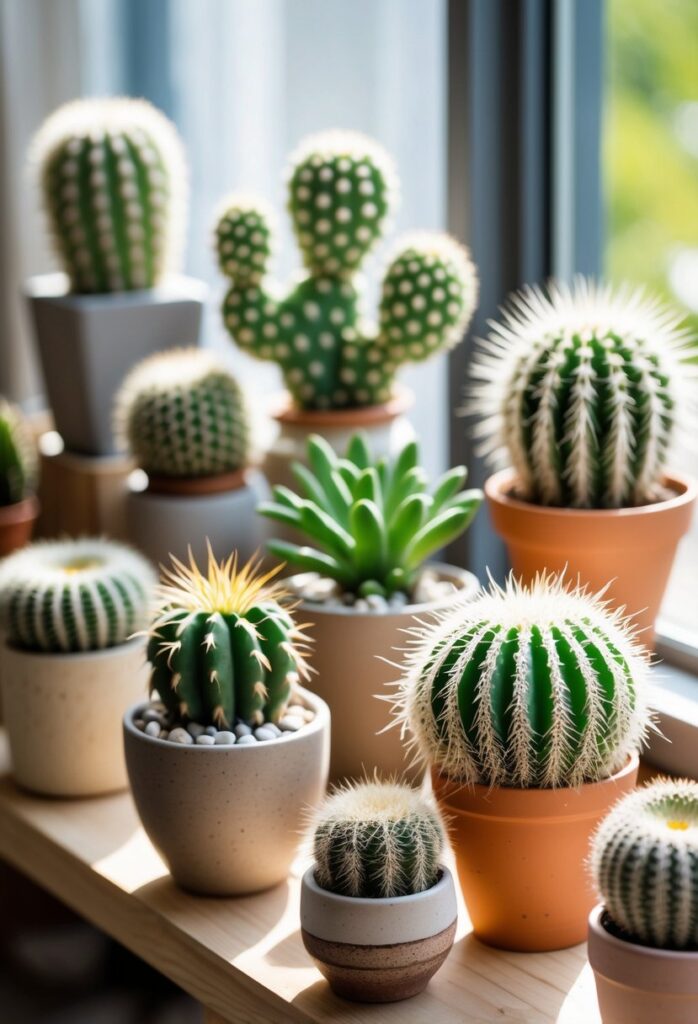
A mini indoor cactus garden is perfect for those who want greenery without much effort. Cacti are known for needing little water and care. They can thrive in small pots and various indoor lighting conditions.
Choosing low-maintenance cactus species helps keep the garden easy to manage. Some popular types include the moon cactus, golden barrel cactus, and bunny ear cactus. These plants stay small and do well inside.
Using small containers or trays helps keep the garden compact and organized. Adding decorative stones or sand around the base improves the look and keeps soil in place. It also helps prevent overwatering.
Placing the mini garden near a window with indirect light suits most cacti. They do not need constant direct sunlight, but they do prefer bright spaces. Watering only when the soil is dry keeps the plants healthy.
This type of garden fits well on desks, shelves, or tables. It adds a simple, natural touch to indoor areas without requiring frequent care.
11) Use tiered planting arrangements for visual depth
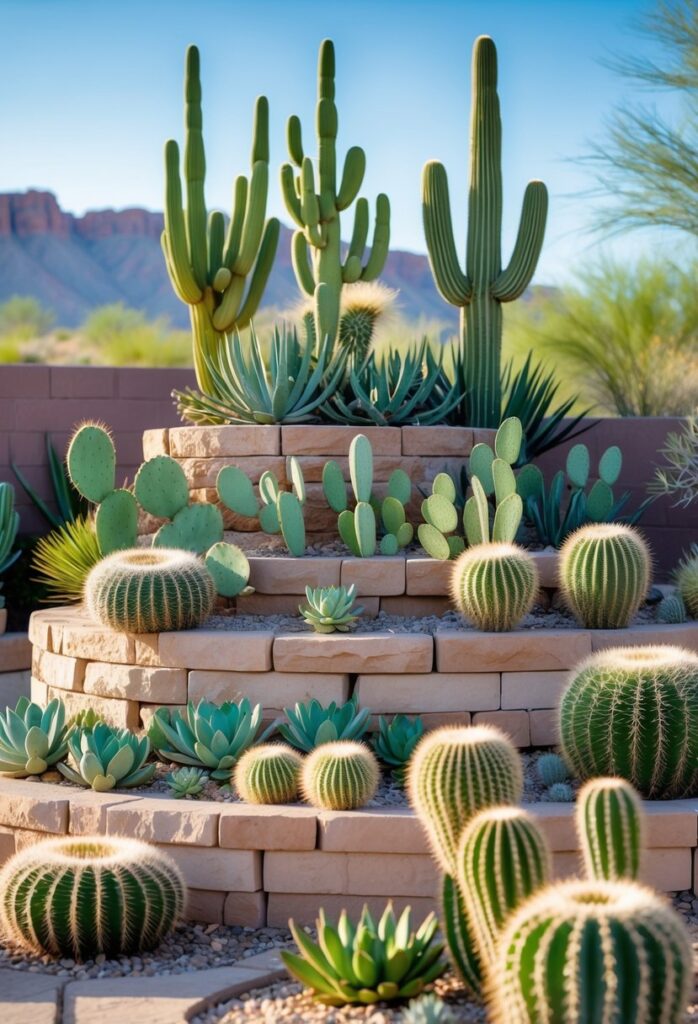
Using tiered planting arrangements adds layers and depth to a cactus garden. It helps show off different shapes and sizes clearly. Taller cacti can go in the back, with shorter ones placed in front.
Raised beds or tiered stands are good tools for creating these layers. They lift plants to different heights, making the garden more interesting to look at. This also makes it easier for each cactus to get sunlight.
The variety in height breaks the flatness of a garden space. It creates a natural flow for the eyes to follow. This simple strategy works well indoors or outdoors.
By mixing cactus types on different levels, the gardener can highlight their unique forms. Using tiered arrangements keeps cactus plants organized while still looking natural. It is a practical and attractive way to design a cactus garden.
12) Integrate native desert plants for authenticity
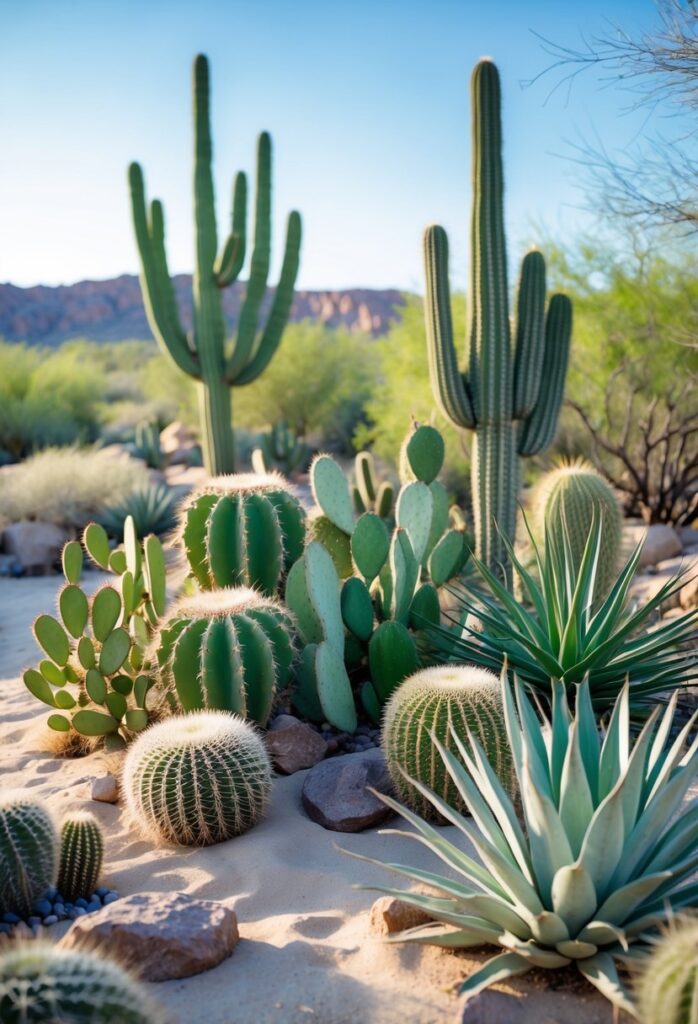
Using native desert plants adds a genuine feel to a cactus garden. These plants are naturally suited to the environment, making them easier to grow and maintain. They also help support local wildlife like birds and insects.
Native plants often need less water and care than non-native species. They can handle the heat, dry soil, and occasional storms typical of desert areas. This makes the garden more sustainable and practical.
Combining native plants with cacti creates a natural look. Different shapes, sizes, and textures of desert plants add visual interest. It also helps the garden blend more smoothly with its surroundings.
Choosing a mix of native succulents, shrubs, and small trees can enhance the garden’s diversity. Examples include agave, yucca, and desert wildflowers. These plants work well with cacti and add color and structure.
Incorporating native plants supports a balanced ecosystem and encourages biodiversity. It is a smart step for anyone wanting an authentic and low-maintenance desert garden.
13) Build a no-fuss garden using drought-resistant cactus species
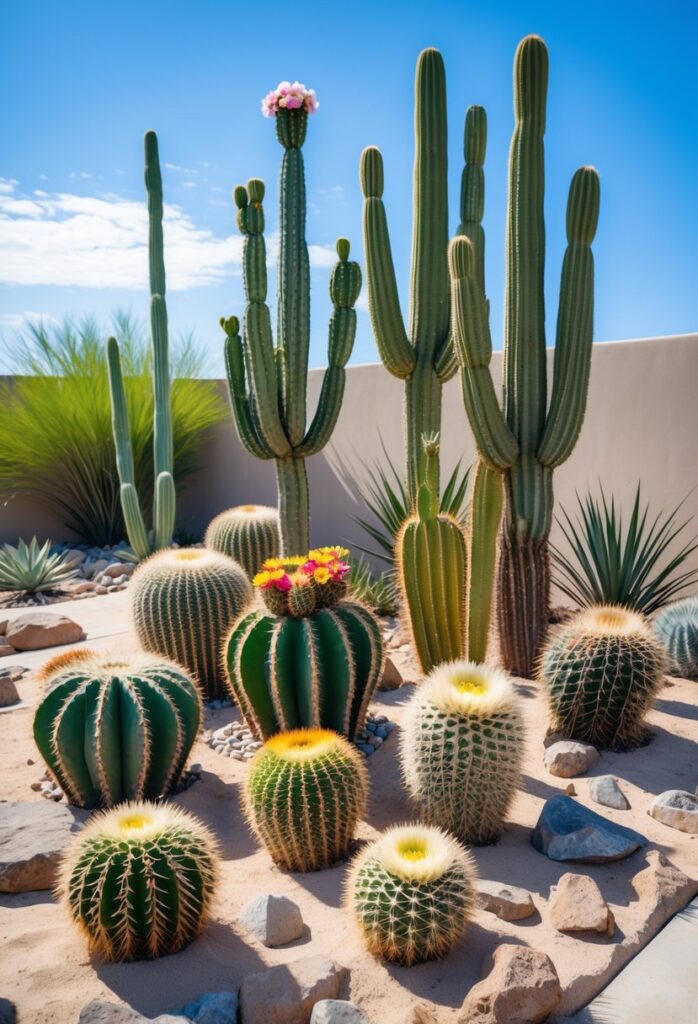
He can create a simple garden by choosing drought-resistant cactus species. These plants need very little water and can survive in hot, dry conditions. This reduces the time spent on watering and care.
They thrive well in sunny spots with good drainage. Using gravel or sand helps keep water from sitting around the roots, which can cause rot. Adding rocks can improve the garden’s look while helping with drainage.
She might mix different cactus shapes and sizes for visual interest. Tall, skinny cacti paired with round, small ones create a natural feel without needing much work. Containers can also be used to keep the garden compact and easy to manage.
This type of garden suits busy people or those new to gardening. It offers a low-maintenance way to enjoy plant life without the usual fuss. Drought-resistant cacti ensure the garden stays healthy even with little attention.
14) Design pathways with crushed rocks or gravel to guide the viewer
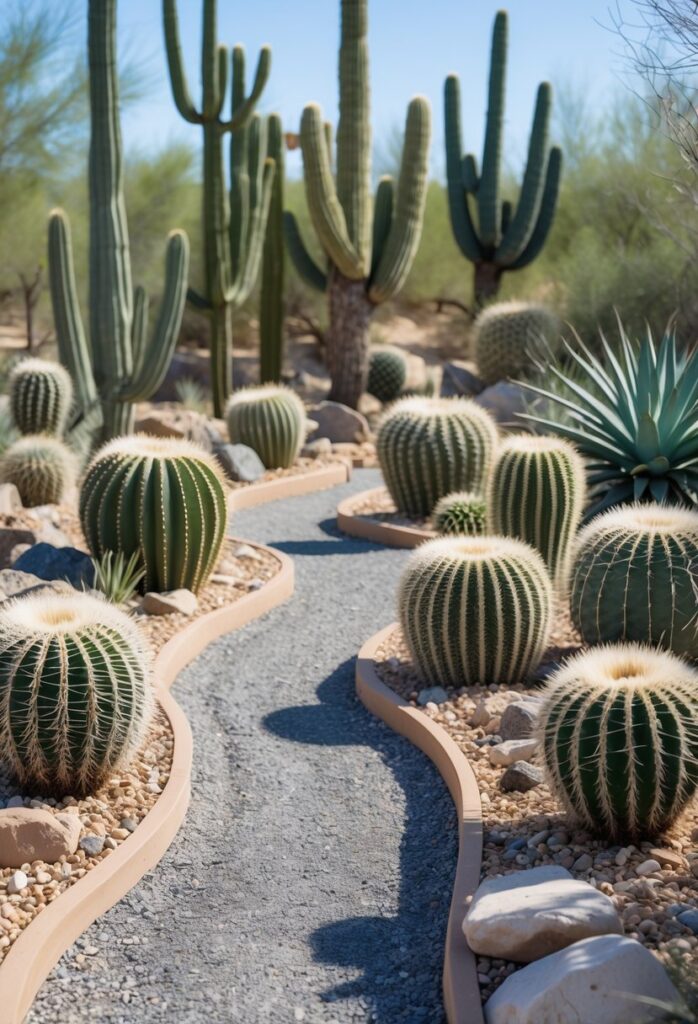
Pathways made from crushed rocks or gravel help organize a cactus garden by creating clear routes for visitors to follow. These materials are durable and blend well with the natural desert look of cactus plants.
Using gravel or crushed stone allows for easy shaping of paths. They can curve around different plants, making the garden more interesting without distracting from the cacti themselves.
Gravel paths are low-maintenance and good for drainage. This keeps water from pooling near the cacti, which prefer dry conditions.
Adding stepping stones or borders along the gravel can provide extra definition. This makes the pathway safer and visually appealing while keeping the focus on the plants.
Overall, crushed rock or gravel pathways make a cactus garden feel more inviting and structured. They help guide guests but don’t compete with the harsh, simple beauty of the plants.
Design Principles for Cactus Gardens
A successful cactus garden focuses on using different textures and heights to create visual interest. Choosing the right color combinations can also enhance the overall look when combined with succulents.
Balancing Texture and Height
Texture and height bring depth and shape to a cactus garden. Taller cacti like saguaro or organ pipe add vertical lines. These are best placed toward the back or center of the garden.
Shorter, rounder cacti such as pincushions fill in the lower areas. Mixing spiky plants with smoother or ribbed ones creates contrast.
Layering plants by height also helps with sunlight exposure. Taller plants provide partial shade for smaller ones that need it. This arrangement avoids overcrowding and allows airflow.
Grouping cacti with similar water and sunlight needs keeps the garden healthy. Using rocks or gravel between plants emphasizes the texture and gives a clean look.
Color Schemes With Succulents
Colors in a cactus garden come from both the plants and their blooms. Green is dominant, but many cacti have blue, gray, or even purple tones.
Succulents add more options with various shades of red, orange, and silver. Combining warm and cool colors can brighten the garden or create a calm, earthy palette.
Flower color also matters. Bright reds, yellows, and pinks from blooms add seasonal pops of color against the green backdrop.
Using planters or stones in neutral colors like beige or terracotta helps keep the focus on the plants. It also ties the garden together visually.
Choosing colors that suit the local climate and sunlight keeps the garden vibrant and reduces the risk of fading or stress.
Caring for Your Cactus Garden
Proper care ensures cacti stay healthy and vibrant. It involves choosing the right soil and drainage to prevent root problems. Seasonal attention helps cacti adjust to changing weather and grow well all year.
Soil and Drainage Essentials
Cacti need soil that drains quickly to avoid root rot. A mix of sand, gravel, and organic matter works best. This mix keeps water moving and air reaching the roots.
Using pots or garden beds with drainage holes is important. Without them, water can build up and harm the plants. Raised beds or mounds improve drainage in outdoor gardens.
Regularly checking soil moisture helps. It should dry out completely between waterings. Overwatering is the most common cause of cactus problems, so it must be avoided.
Seasonal Maintenance Tips
In warmer months, cacti may need light watering every 1-2 weeks. They thrive in bright, direct sunlight, so placing them where they get several hours of sun is ideal.
During colder months, watering should be reduced or stopped. Many cacti go dormant and need less moisture then. Protecting them from frost is key, especially in outdoor gardens.
Removing dead or damaged parts improves health. Occasional feeding with a low-nitrogen fertilizer during the growing season supports growth but should be done sparingly.
